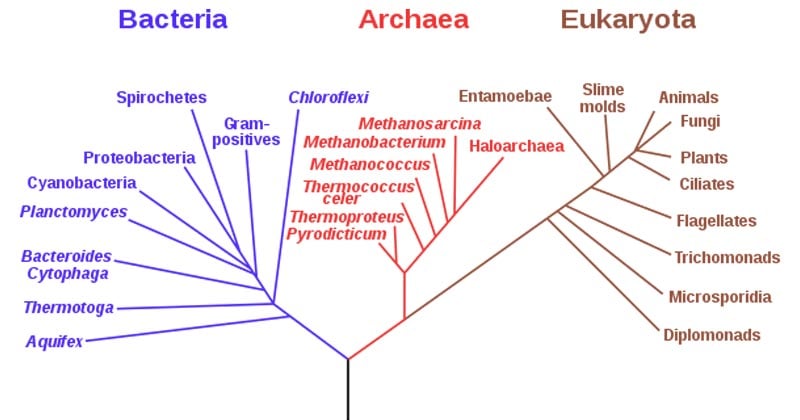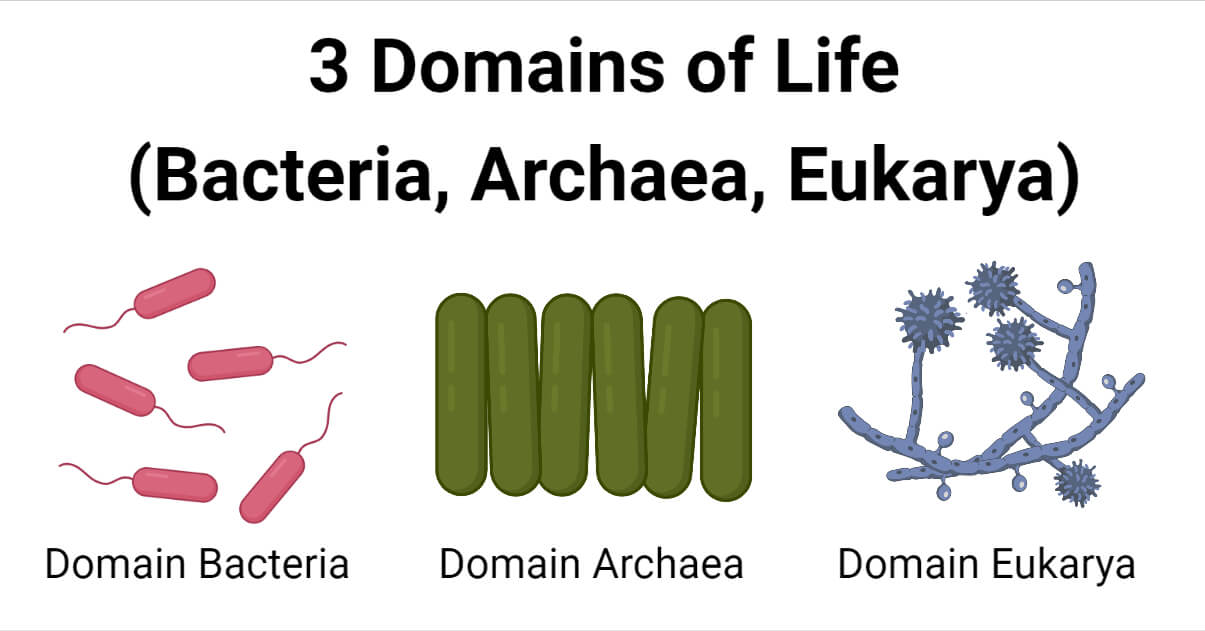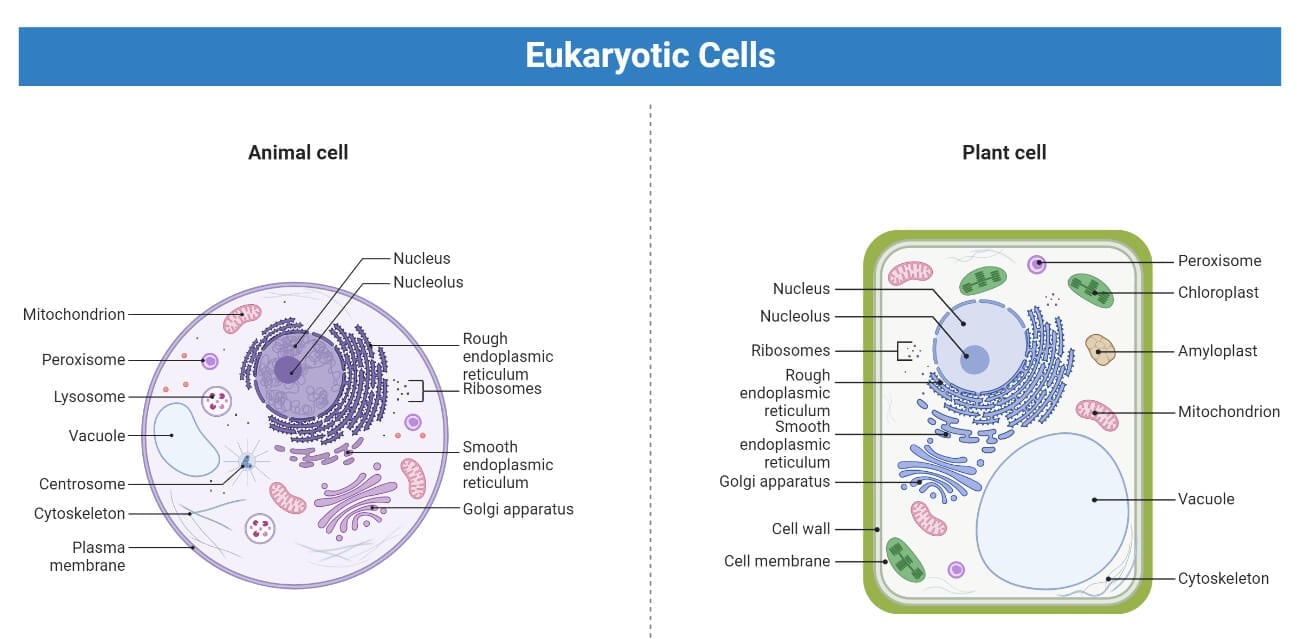The primitive living world was classified into two primary domains of Eukaryotes (Eukarya) and Prokaryotes (Bacteria) based on microscopic characteristics such as the presence or absence of membrane-bound nuclei and other cellular organelles. In 1977, American microbiologist and physicist Carl Richard Woese and his co-workers discovered the third domain of life, Archaea based on distinctive 16S ribosomal RNA (rRNA) signature sequences which had long been categorized as prokaryotic organisms. This became widely accepted as the third domain in 1990. Similar nature of cells led to hypotheses on the origin of all cells from a common ancestor termed the Last Universal Common Ancestor (LUCA), also known as the theoretical ancestor of Bacteria, Archaea and Eukarya. Thus, he reorganized the Tree of Life (ToL) into three separate Domains: Archaea, Eukarya, and Eubacteria (true bacteria), and pioneered a novel view of the biological world.
The conclusions drawn out of research conducted by Woese that led to the differentiation of archaea from bacteria are listed as:
- Both of them differed in 16S rRNA genes. Archaea possesses three RNA polymerases while bacteria have only one.
- Archaeal cell walls consist of pseudopeptidoglycan however, bacterial cell walls are made of peptidoglycan and lipopolysaccharide (LPS).
- Archaea shared more close phylogenetic evolutionary relationship with eukaryotes than with bacteria.

The application of a genetic approach rather than similarities based on morphology has revolutionized the evolutionary study as these rRNA genes, that are universally distributed and conserved in every organism have helped to trace our ancestors and apprehend the point of diversification of life.
Interesting Science Videos
Characteristics of three domains
The primitive conditions of the early earth exhibited a very hot climate with a lot of active volcanoes and a gaseous atmosphere of methane, carbon dioxide, ammonia, and water with oxygen present scarcely. Archaea and some bacteria evolved and acclimated to those primitive conditions of early Earth.
1. Domain Bacteria (Kingdom: Eubacteria (True bacteria))
Bacteria are unicellular prokaryotic microscopic organisms. Their unique feature covers the presence of peptidoglycan in the cell wall unlike the Archaea and Eukarya, membrane composed of unbranched fatty acid chains attached to glycerol by ester linkages and their unique rRNA type. Examples: Cyanobacteria, Mycoplasmas, Gram-Positive bacteria, and Gram-negative bacteria. These are sensitive to most antibacterial antibiotics however show resistance against antibiotics that affect Eukarya. They show the asexual mode of reproduction. Generally, these are pathogenic but some are part of essential microbiota such as commensals. Such commensals play a vital role in digestion and absorption of foods, preventing pathogen colonization, activation of the immune system, and many more.
Bacteria are considered to be the primary decomposers of the natural ecosystem. These are grouped into five categories:
- Cyanobacteria: Blue-green algae capable of carrying out photosynthesis are termed cyanobacteria.
- Chlamydiae: Parasitic bacteria such as Chlamydia trachomatis and Chlamydophila pneumoniae that reproduce within host’s cells comprises chlamydiae.
- Firmicutes: Clostridium, Bacillus, and Mycoplasmas are Gram-positive bacteria belonging to firmicutes.
- Proteobacteria: It is a phylum of Gram-negative bacteria which are further classified as alpha-, beta-, gamma-, delta-, and epsilon proteobacteria. These form the part of normal human microbiota as well as many pathogens,
- Spirochetes: These have long, helically coiled cells with distinctive diderm (double-membrane) exhibiting a twisting motion with their axial filaments. For example: Borrelia, Leptospira, Treponema, etc.

2. Domain Archaea (Kingdom: Archaebacteria)
These are unicellular prokaryotic organisms that resemble bacteria in their appearance, and hence were fallaciously placed under bacteria before the rise of three domain systems. These are the foremost primitive and ancient forms among the three domains and are known to be present within the most extreme conditions of the environment. For example, acidophiles- live at pH below 1, alkaliphiles- live in very salty environments, thermophiles- live at high temperatures (113°C), psychrophiles- live in cold temperatures (4°C), methanogens- produce the gas methane, thermoacidophiles-withstand acidic high-temperature water, etc. Contrary to this, all archaea are not extremophiles as it has been recorded from normal environments such as soil, and ocean, and also found to cohabit with bacteria like within the human gut, the occurrence of methane-producing archaea. Their unique characteristics include their membranes chemistry which consists of branched hydrocarbon chains attached to glycerol by ether linkages that helps to stabilize them even under extreme environments. They share a number of of the properties that are common to either bacteria or eukaryotes.
Similarities with bacteria
- Unicellular prokaryotic nature
- Absence of membrane-bound nucleus and other internal structures
- Occurrence of single circular chromosome- a chunk of circular, double-stranded DNA (dsDNA)
- Asexual reproduction by the fission process
- Presence of flagella for locomotion in their environment
Archaea show resemblance to eukaryotes specifically for the enzymatic machinery associated with the processing of genetic information like DNA packaging and replication, RNA transcription, and protein translation. These don’t have a peptidoglycan layer in their cell envelope and are immune to antibiotics that affect the bacteria but are sensitive to some antibiotics that influence the Eukaryotes. Recent conclusions made by biologists after Woese proposed three equal domains, suggested eukaryotes to be the direct descendants of archaea rather than sister groups. The three main phyla that come under Archaea are Crenarchaeota, Euryarchaeota, and Korarchaeota.
- Crenarchaeota includes mainly hyperthermophiles and thermoacidophiles.
- Similarly, methanogens constitute the members of the Euryarchaeaota phylum.
- Very little discovery has been done about Korarchaeota. These are found very rarely in nature and are thought to be the oldest lineage of archaebacteria.
3. Domain Eukarya
Eukarya is the only domain that represents multicellular, nucleated, and visible organisms with distinct membrane-bound cell organelles although single-celled eukarya also exist. These lack peptidoglycan in their cell envelope and have distinct rRNA from bacteria and archaeans. The presence of a double-membrane nucleus with pores, allows DNA enclosed within to move in and out of it. Cell division involves the process of mitosis and cytokinesis. These generally show two modes of reproduction: mitosis and meiosis as means of asexual and sexual reproduction. Besides these, it’s characterized by the complex cellular organization with unique features that include the endoplasmic reticulum, acidified vacuoles, Golgi complex, eukaryotic telomeres, 9+2 flagellar apparatus, mitotic spindle formation, and presence of specific genes and proteins like tubulins, actin, myosin, calmodulin, etc. It’s further subdivided into four kingdoms namely:
- Kingdom Protista
These are unicellular eukaryotes except the brown algae, which is multicellular and reproduce asexually and sexually by cell fusion and zygote formation. Examples: Slime molds, Chrysophytes, Dinoflagellates, Euglenoids, and Protozoans.
- Kingdom Fungi
These are multicellular, heterotrophic eukaryotes having specialized cell walls made of chitin and reproduce sexually, asexually, and vegetatively. However, some fungi such as yeasts are unicellular. Examples: Mucor, Aspergillus, Agaricus, etc.
- Kingdom Plantae
It includes all multicellular, autotrophic eukaryotic organisms except some that are partially heterotrophic such as insectivorous plants or parasites. Their cell walls are mainly made of cellulose and are non-motile. Their lifecycle exhibits a phenomenon referred to as alternation of generation.

- Kingdom Animalia
It includes multicellular, heterotrophic eukaryotic organisms. They lack cell walls, are motile, and demonstrate the sexual mode of reproduction by the copulation of male and female followed by embryological development.
In the 1960s, a theory called the Endosymbiotic theory was proposed by the scientist Lynn Margulis to define the origin of organelles such as mitochondria and chloroplasts within the eukaryotic cells from prokaryotic cells.
What is Endosymbiotic Theory???
- Palaeontological evidence suggests the primary appearance of prokaryotic cells around 4 billion years ago while eukaryotic cells appeared just 1.8 billion years ago. This led to a quest for whether the ancestor of all eukaryotic cells was a prokaryote?
- Endosymbiotic theory states that one prokaryotic cell(host) engulfed another prokaryotic cell through the process of infolding where both cells lived in a symbiotic relationship and thrived together. Newly formed cells were capable of reproduction and were called eukaryotes for having their membranes bound to organelles.
Evidence supporting this theory are:
- Membranes: Mitochondria and chloroplast are membrane-bound- the same as prokaryotic cells.
- DNA: Mitochondria and chloroplast have their own circular DNA where chloroplast DNA resembles photosynthetic blue-green bacteria and mitochondrial DNA resembles aerobic bacteria.
- Reproduction: Mitochondria and chloroplast reproduce by binary fission as the bacteria do.
- Size and morphology: Mitochondria and chloroplast exhibit similar size and morphology to bacteria.
- Nature and size of ribosomes: Ribosomes of bacteria, chloroplasts, and mitochondria are similar in size and are the 70S (50S and 30S subunits) type.
- Sensitivity to antibiotics: Antibiotics suited to inhibit protein synthesis in bacteria also inhibit protein synthesis in chloroplast and mitochondria.
References
- Amils, R., Gargaud, M., Quintanilla, J. C., Cleaves, H. J., Irvine, W. M., Pinti, D., & Viso, M. (2011). Encyclopedia of Astrobiology. https://doi.org/172910.1007/978-3-642-11274-4
- https://biologywise.com/three-domains-of-life
- https://bio.libretexts.org/Bookshelves/Microbiology/Book%
- https://astrobiology.nasa.gov/news/the-three-domains-of-life/
- https://earthhow.com/3-domains-of-life/
- https://microbiologysociety.org/publication/past-issues/what-is-life/article/archaea-and-the-meaning-of-life-what-is-life.html
- https://courses.lumenlearning.com/wm-nmbiology1/chapter/reading-phylogenetic-trees-2/
- https://biologydictionary.net/domain/
- https://www.thoughtco.com/three-domain-system-373413
- https://www.bioexplorer.net/domain-eukarya.html/
- https://link.springer.com/referenceworkentry/10.1007/978-3-642-11274-4_537
- https://study.com/academy/lesson/eukarya-definition-characteristics-examples.html
